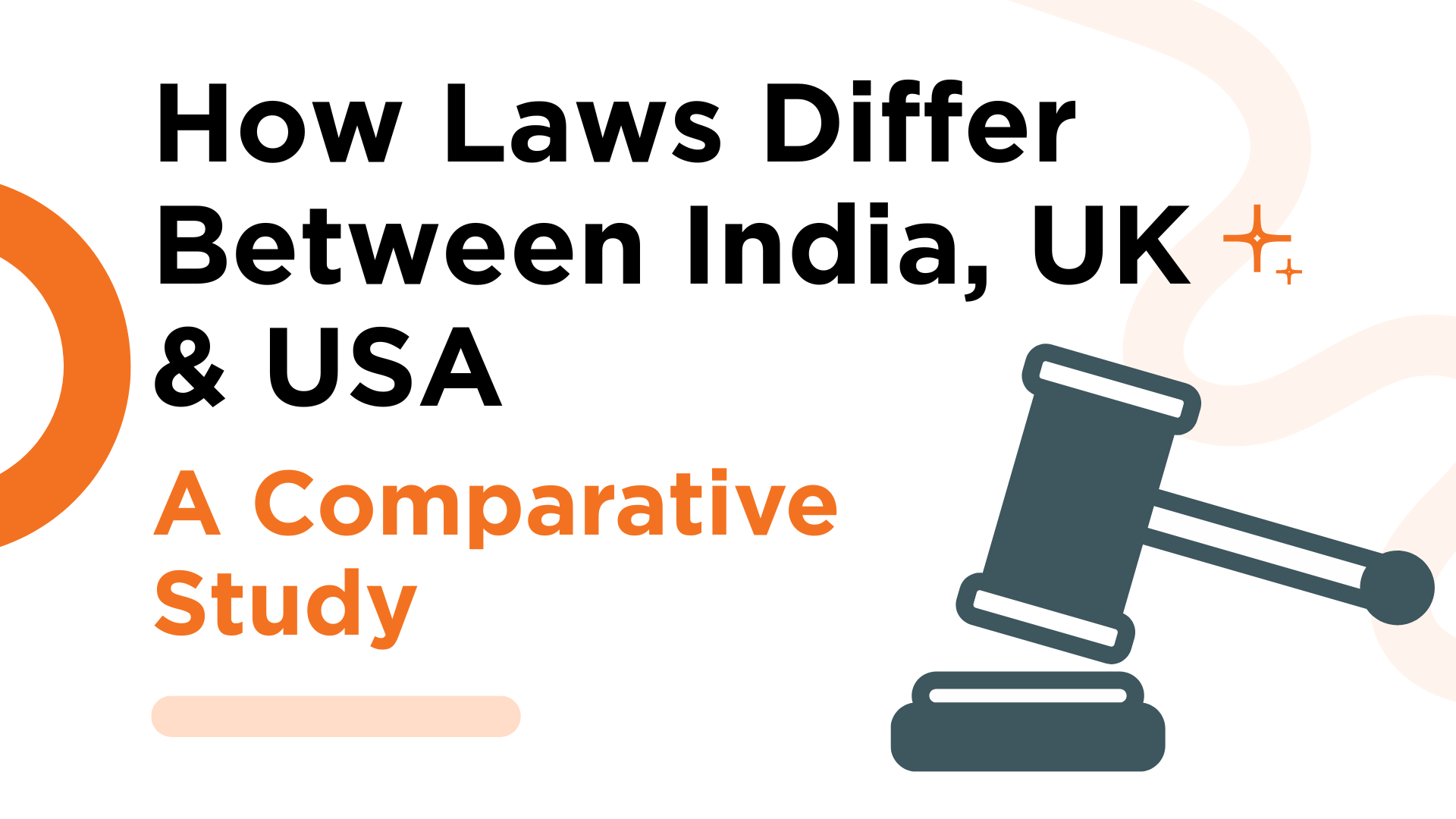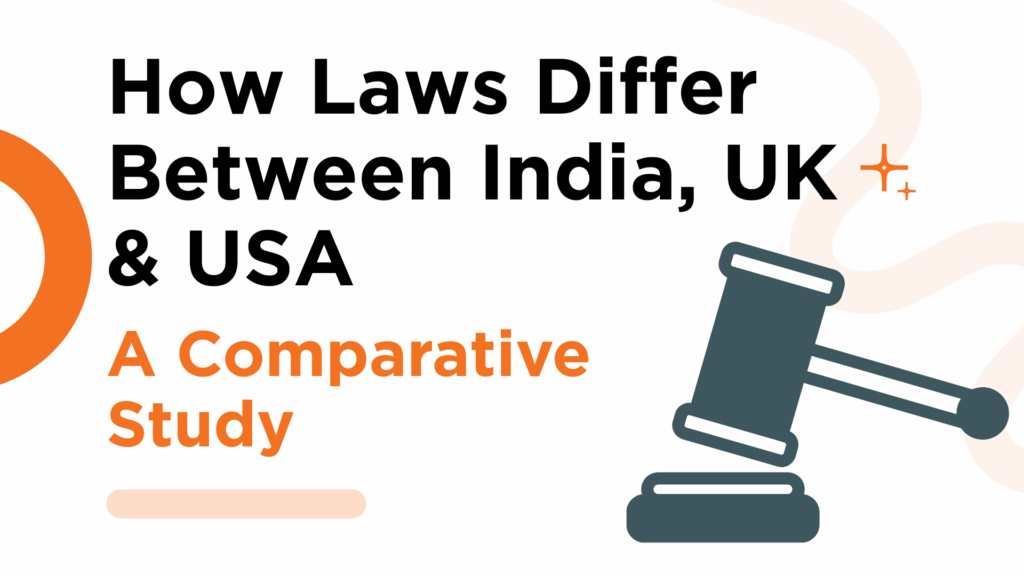In this post you will know How Laws Differ Between India, the UK, and the USA. A Comparative Study has been presented here in a simplified manner.
How Laws Differ Between India, UK & USA: A Comparative Study
India, the UK, and the USA each have well-established legal systems, but their foundations, structures, and legal principles vary significantly due to historical, political, and cultural influences. Understanding these differences is essential for students of law, policy analysts, and professionals engaged in international legal matters.
This comparative overview highlights the core distinctions across civil, criminal, and constitutional laws, as well as the roles of courts and legal institutions in each country.
Legal Origins and Structure
| Aspect | India | UK | USA |
|---|---|---|---|
| Legal origin | Common Law (British legacy) | Common Law | Common Law with Constitutional supremacy |
| Constitution | Written, adopted in 1950 | Unwritten (based on statutes and precedents) | Written, adopted in 1787 |
| Government type | Parliamentary democracy | Constitutional monarchy | Federal presidential republic |
| System | Quasi-federal with unitary features | Unitary | Federal |
While India and the UK follow parliamentary systems, the USA has a clear separation of powers between the executive, legislature, and judiciary.
Civil and Criminal Law: Key Differences
Civil Law
- India: Based on statutes like the Indian Contract Act, Transfer of Property Act, etc. Remedies include compensation and injunction.
- UK: Heavily reliant on judicial precedents and statutory interpretation. Tort law plays a central role.
- USA: Civil law is influenced by federal and state jurisdictions. Class action suits are common.

Criminal Law
| Aspect | India | UK | USA |
|---|---|---|---|
| Criminal code | Indian Penal Code (IPC), CrPC | No single codified criminal law | Federal and state penal codes |
| Burden of proof | Beyond reasonable doubt | Beyond reasonable doubt | Beyond reasonable doubt |
| Death penalty | Legal but rare | Abolished (except in some overseas territories) | Legal in many states; actively used |
| Trial system | Adversarial; judge-led | Adversarial; jury used for serious cases | Adversarial; jury trial common |
The U.S. system is jury-oriented, while India relies more on judge-led trials. The UK balances both based on the severity of the case.
Constitutional and Fundamental Rights
| Rights | India | UK | USA |
|---|---|---|---|
| Bill of Rights | Part III of the Constitution | No formal bill; rights derived from laws and treaties | Bill of Rights (first 10 Amendments) |
| Free speech | Subject to reasonable restrictions | Limited by hate speech and libel laws | Strong protection; even for controversial speech |
| Right to privacy | Recognized by Supreme Court (2017) | Recognized through case law | Explicit under the Fourth Amendment |
| Religious freedom | Guaranteed, with some state limitations | Freedom with secular state policy | Strongly protected by the First Amendment |
In India, rights are constitutionally guaranteed but subject to reasonable restrictions. The U.S. has a more absolute view, while the UK relies on common law and Parliament.
Judiciary and Legal Profession
- India: A single integrated judiciary with the Supreme Court at the top. Judges are appointed through a collegium system.
- UK: Multiple legal systems (England and Wales, Scotland, Northern Ireland). Judges appointed by the Crown on recommendations.
- USA: Dual judicial system (federal and state). Judges in higher courts (including Supreme Court) are nominated by the President and confirmed by the Senate.
Lawyers in all three countries are subject to strict licensing requirements. However, the UK distinguishes between solicitors and barristers, unlike India and the U.S.
Laws on Social Justice and Equality
India’s laws focus heavily on social justice due to its diverse and unequal society. Affirmative action (reservations), protection for minorities, and welfare laws are constitutional mandates.
The UK emphasizes equality through human rights legislation like the Equality Act 2010. In contrast, the U.S. applies civil rights laws and anti-discrimination statutes more vigorously through the courts.
Summary of Differences
| Legal Element | India | UK | USA |
|---|---|---|---|
| Constitution | Written, detailed | Unwritten, evolving | Written, rigid |
| Type of Law | Common + Civil Statutes | Common Law | Federal Constitutional Law |
| Fundamental Rights | Restricted by public interest | Derived from statutes | Strong, individually enforceable |
| Judicial Review | Strong | Limited (Parliament sovereign) | Strong, especially in Supreme Court |
| Jury Trials | Rare | Limited | Frequent in criminal and civil cases |
Conclusion
While India, the UK, and the USA share a common law heritage, their legal systems have diverged significantly over time. India blends its colonial legacy with constitutional ideals. The UK relies on precedent and legislative supremacy, and the USA emphasizes individual liberties and federalism.
Understanding these legal contrasts is vital for comparative law studies, global business practices, and international legal collaboration.
We are thankful for the time you have spent in reading this post.





